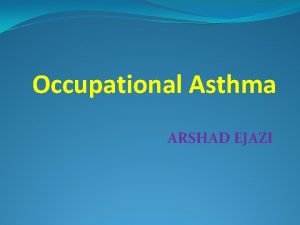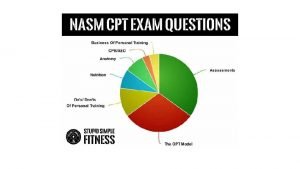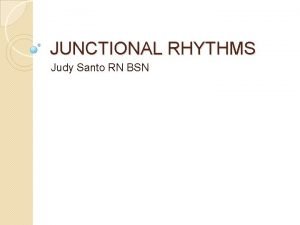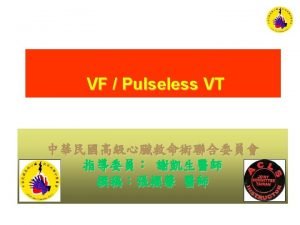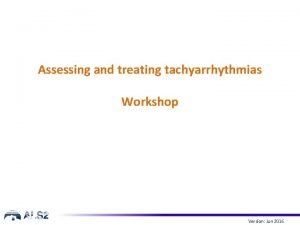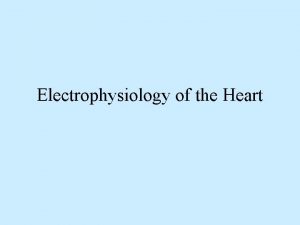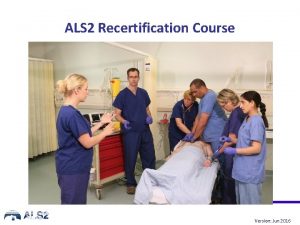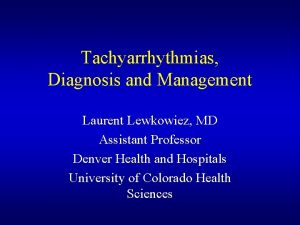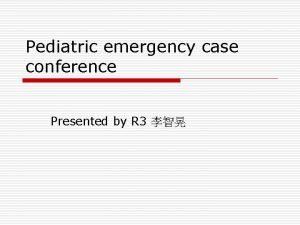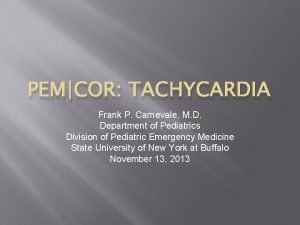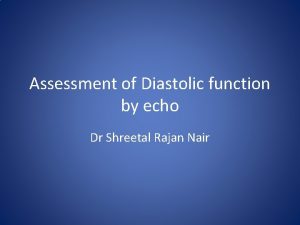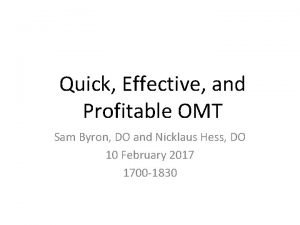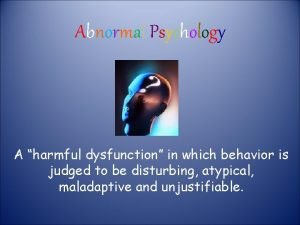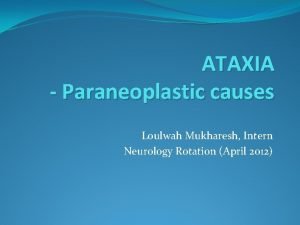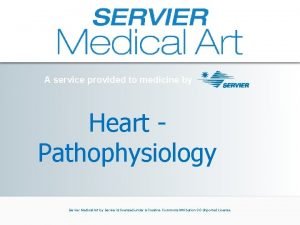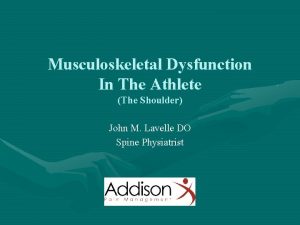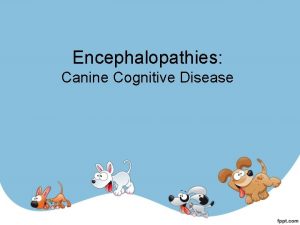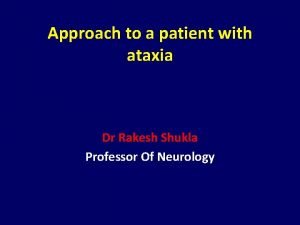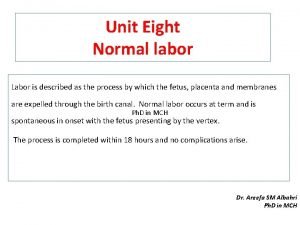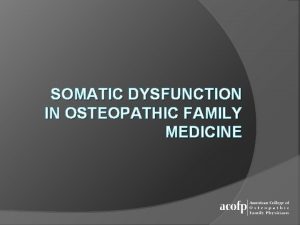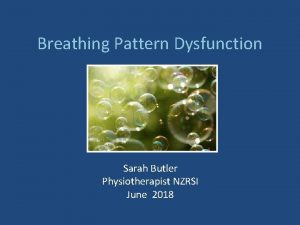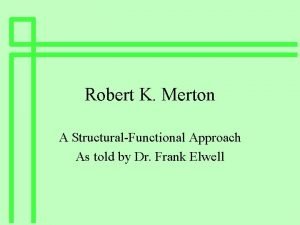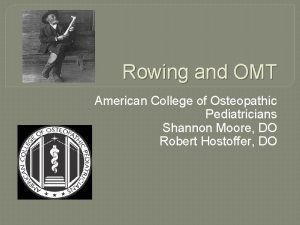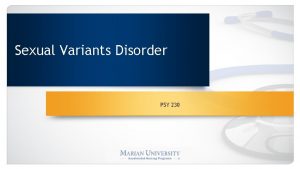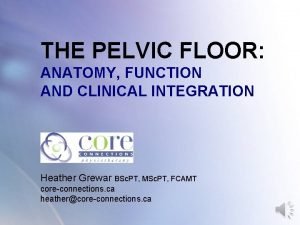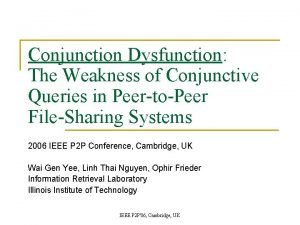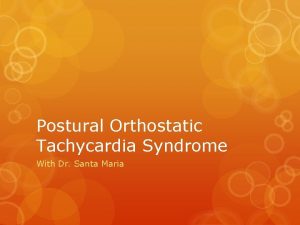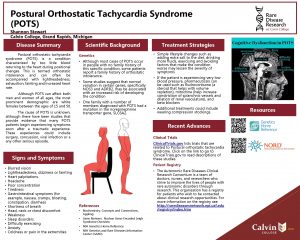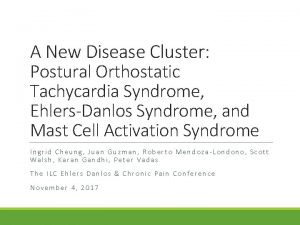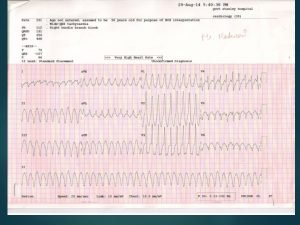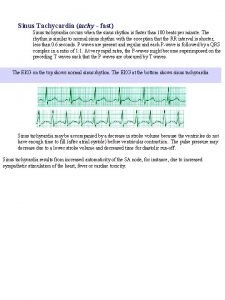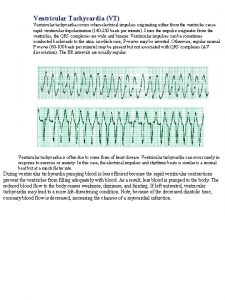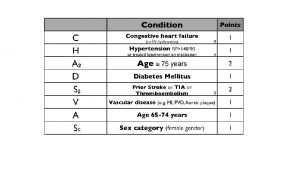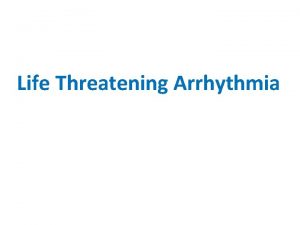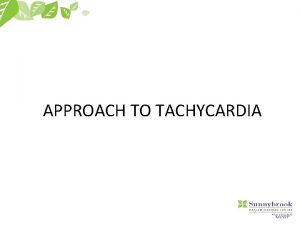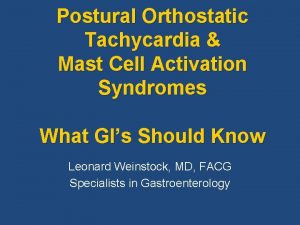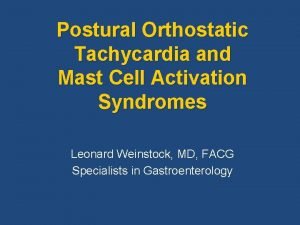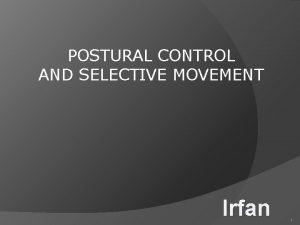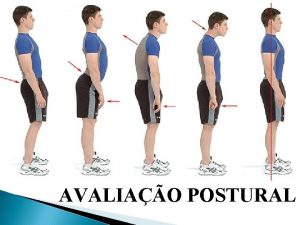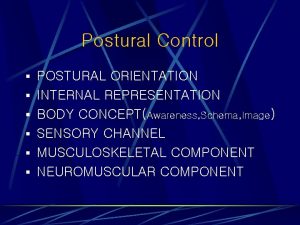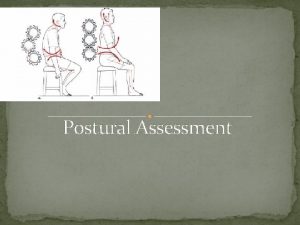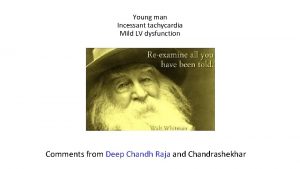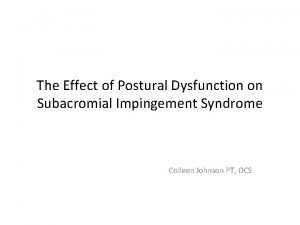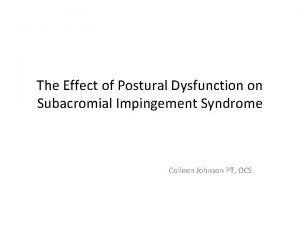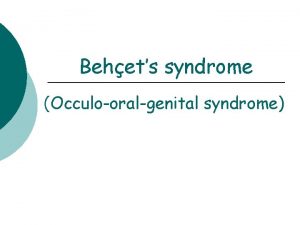Gastrointestinal Dysfunction in Postural Tachycardia Syndrome Anna De






























- Slides: 30

Gastrointestinal Dysfunction in Postural Tachycardia Syndrome Anna De. Pold Hohler, MD, AAN Associate Professor of Neurology Boston University School of Medicine

Objectives � Overview � Po. TS: of Autonomic System ◦ History ◦ Pathophysiology ◦ BU survey data - symptoms � GI dysfunction in POTS � Treatment and Management

Overview of Autonomic System � Central autonomic nervous system � Peripheral autonomic nervous system � Sympathetic and parasympathetic innervation ◦ smooth muscle, cardiac muscle, and glands � Regulates heart rate, blood pressure, digestion, urination, sexual function

Normal Physiology � gravitational pooling of blood from the thorax into lower extremities � results in a decrease of blood return to the heart decreased stroke volume and cardiac output � monitored by baroreceptors in carotid sinus and aortic arch � increases in HR, contractility, and peripheral resistance maintain MAP and CBF Iwase et al, Front Physiol. , 2014

Normal Physiology � Arterial wall stretch stimulation of baroreceptors CN IX and X nucleus tractus solitarius in medulla � Involvement of both glutamatergic and GABAergic neurons to transmit signals from caudal to rostral medulla � Exit spinal cord � NTS Dorsal motor nucleus of vagus and nucleus ambiguus CN X heart, vessels Iwase et al, Front Physiol. , 2014

Sympathetic pathway � cardiac sympathetic activity and the activity of muscle sympathetic nerves � Innervation of skeletal muscles � When BP rises: vagus nerve (parasympathetics) is activated � When BP is low: suppresses vagus nerve activity

http: //accessphysiotherapy. mhmedical. com/data/Multimedia/grand. Rounds/motorpathways/media/motorpathways_print. html

Sympathetic v. Parasympathetic � Sympathetic ◦ ◦ system: “Fight or flight: ” emergencies, exercise Long post-ganglionic fibers Highly branched Multi-organ innervation � Parasympathetic ◦ ◦ system: “Rest and digest: ” conserving energy Short post-ganglionic fibers Few branches Localized effect

http: //droualb. faculty. mjc. edu

Postural Orthostatic Tachycardia Syndrome (Po. TS) � Typically young females ages 15 -40 � Adults: increase in heart rate of 30 beats per minute (bpm) or more within 10 minutes of head-up tilt or standing or HR >120 beats � Children: increase in heart rate of 40 beats or more within 10 minutes of standing � Orthostatic intolerance without orthostatic hypotension

History of Po. TS � 1871 - described by Jacob Mendes Da Costa � First World War- Sir Thomas Lewis � 1941 - Paul Wood � � ◦ American Civil War- irritable heart syndrome ◦ “soldier’s heart” ◦ Da Costa Syndrome (anxiety neurosis) ◦ Implying non-organic component Postural tachycardia syndrome” coined in 1982 by Rosen and Cryer. Patient with postural tachycardia without orthostatic hypotension Estimated prevalence is 170/100, 000 Mathias et al, Nat. Rev. Neurol. , 2012

Autonomic Symptoms � Dizziness � Lightheadedness � Palpitations � Syncope � Fatigue, headaches, nausea, distention, abdominal pain, constipation or irritable bowel syndrome, urinary retention, skin changes, sleep changes

Triggers and exacerbating factors � Febrile illness, trauma or surgery � Food (large quantities) � Alcohol � Exercise � Heat � Menstrual period � Medications that cause vasodilation Mathias et al, Nat. Rev. Neurol. , 2012


Postural Orthostatic Tachycardia Syndrome (Po. TS) and its associated symptoms � Prospective qualitative survey with 37 questions � 80 patients with autonomic dysfunction � 40 patients with Po. TS � diagnosed based on symptoms of orthostatic intolerance accompanied by a HR rise ≥ 30 beats per minute which occurred within the first 10 min of upright posture

Results � Autonomic symptoms: � 87. 2% lightheadedness with standing � 69. 2% worsening symptoms in the morning � Gastrointestinal dysfunction: � Irritable bowel symptoms 46% � Swallowing difficulty 41%


GI dysfunction in POTS � � � A 30 -question survey of GI symptoms was collected from 28 patients with POTS seen in the Boston Medical Center Autonomic Clinic. Answers were recorded on a Likert rating scale. Symptoms were positive if patients answered “strongly agree” or “agree” and negative if they answered “strongly disagree” or “disagree. ” Responses were collected analyzed. Results: The most commonly reported GI symptoms were nausea (86%), irregular bowel movements (71%), abdominal pain (70%), and constipation (70%). Additionally, 82% of patients reported having GI symptoms more than once per week, and 71% reported having seen a GI specialist, and symptoms did not improve with changes in position. Twelve patients had undergone a gastric emptying study, and six of these patients reported receiving a diagnosis of gastroparesis or delayed gastric emptying. Conclusions: GI disturbances are common, frequent, and prolonged in patients with POTS, likely impacting quality of life. Given the importance of the enteric nervous system to normal GI functioning, the same autonomic impairment leading to POTS may result in abnormal gut motility and ultimately subjective GI discomfort.

GI symptoms � Nausea, bloating, constipation, abdominal pain � Change in electrical activity of the stomach in upright positioning � Increased and decreased gastric emptying has been noted as well � Irritable bowel syndrome and functional dyspepsia Park et al, Clin. Auton. Res. , 2013 Safder et al, Pediatr. Gastroenterol. Nutr. , 2010 Seligman et al, Clin. Auton. Res. , 2013

Conservative measures � Hydration: 80 -100 oz/day � High salt diet (300 m. Eq/d) � Small, frequent meals � Tomato juice, salt tabs � HOB elevation � Regular exercise � Physical maneuvers � Compression stockings � Abdominal binder

Dietary Modifications � Small frequent meals � Easily digestible, no raw fruits and veggies unless juiced � Slow cooked vegetables and meats � Hydration with foods � Low lactose and low gluten diet � High B 12, Iron, Vitamin D diet (multivitamin if needed) � For gut shut down- soft solids

GI dysfunction and autonomic instability � Ineffective motility appears to impact nutrient absorption. � In our patient population, individuals with lower gastric motility also had more frequent dehydration, vitamin deficiencies, and worse POTS symptoms. � Optimization of gut function is our priority in improving autonomic stability and optimizing absorption of medications.

Fludrocortisone (Florinef) � Mineralocorticoid, α-1 agonist ◦ expands intravascular volume, reduces salt loss ◦ Dose 0. 1 -0. 5 mg/d � Risk of: ◦ volume overload ◦ hypokalemia or hypomagnesemia � Additional side effects: headache, edema, weight gain, and supine hypertension Robertson et al. , Neurology, 1995

Midodrine (Pro. Amatine) � Peripheral α-1 agonist ◦ Vasoconstriction ◦ Dose: 2. 5 -15 mg (morning, noon, afternoon) � Common Side Effects: pupillary dilation, piloerection, paresthesias, and pruritus � Supine hypertension (avoid bedtime dosing) Low et al. , JAMA, 1997

Pyrodostigmine (Mestinon) � Acetylcholinesterase ◦ Dose: 60 mg TID inhibitor � Significantly improves standing BP in patients with OH � Does NOT worsen supine hypertension � Effective alone or in combination with midodrine � Side effects: Diarrhea, salivation, nausea, vomiting, muscle cramps, fasciculations Singer et al. , J Neurol Neurosurg Psychiatry, 2003 Singer et al. , Arch Neurol, 2006

Droxidopa � Droxidopa (NE prodrug) Phase III trial of 100600 mg TID droxidopa over 8 weeks showed improvement in orthostatic change in BP, symptoms of lightheadedness, and most notably 50% reduction in falls reported on the OHQ (Hauser, 2013) � Improvement in orthostatic tolerance has also been reported in a dose dependent manner in MSA (100 -2000 mg) (Mathias, 2001; Kaufman, 2003)

Yohimbine � α-2 adrenoreceptor antagonist: raises plasma norepinephrine and blood pressure � Side effects: confusion, increase in heart rate, headache, or tremor

Boston University Movement Disorders Group

References � � � � � Iwase S, Nishimura N, Mano T. Role of sympathetic nerve activity in the process of fainting. Front Physiol. 2014; 5: 343. Low PA, Gilden JL, Freeman R, Sheng KN, Mc. Elligott MA. Efficacy of midodrine vs placebo in neurogenic orthostatic hypotension. A randomized, double-blind multicenter study. Midodrine Study Group. JAMA 1997; 277: 1046 -51. Mathias C, Low D, Iodice V, Owens A, Kirbis M, Grahame R. Postural tachycardia syndrome- current experience and concepts. Nature Rev. Neurol. , 2012; 8: 22 -34. Park KJ, Singer W, Sletten DM, Low PA, Bharucha AE. Gastric emptying in postural tachycardia syndrome: a preliminary report. Clin. Auton Res. 2013; 23(4): 163 -167. Robertson D, Davis TL. Recent advances in the treatment of orthostatic hypotension. Neurology 1995; 45(5): S 26 -32. Safder S, Chelimsky TC, O’Riordan MA, Chelimsky G. Gastric electrical activity becomes abnormal in the upright position in patients with postural tachycardia syndrome. J Pediatr. Gastroenterol. Nutr. 2010; 51(3): 314 -318. Seligman WH, Low DA, Asahina M, Mathias CJ. Abnormal gastric myoelectrical activity in postural tachycardia syndrome. Clin. Auton Res. 2013; 23(2): 73 -80. Singer W, Opfer-Gehrking TL, Mc. Phee BR, Hilz MJ, Bharucha AE, Low PA. Acetylcholinesterase inhibition: a novel approach in the treatment of neurogenic orthostatic hypotension. J Neurol Neurosurg Psychiatry 2003; 74: 1294– 98. Singer W, Sandroni P, Tonette L, et al. Pyridostigmine Treatment Trial in Neurogenic Orthostatic Hypotension. Arch Neurol 2006; 63: 513 -518.

Thank you!!
 Dr arshad ejazi
Dr arshad ejazi Dynamic postural assessment: overhead
Dynamic postural assessment: overhead What causes junctional rhythm
What causes junctional rhythm Acls stroke
Acls stroke Als2 tachycardia algorithm
Als2 tachycardia algorithm Coarse v fib
Coarse v fib Private als courses
Private als courses Orthodromic reciprocating tachycardia
Orthodromic reciprocating tachycardia Inappropriate sinus tachycardia ecg
Inappropriate sinus tachycardia ecg Tachycardia treatment
Tachycardia treatment Vagal maneuvers
Vagal maneuvers Dopamine acls
Dopamine acls Junctional rhythm
Junctional rhythm Ivrt echo
Ivrt echo Orthomode transducer tutorial
Orthomode transducer tutorial Executive dysfunction
Executive dysfunction What is harmful dysfunction
What is harmful dysfunction Causes of cerebellar dysfunction
Causes of cerebellar dysfunction Creative commons
Creative commons Rib somatic dysfunction
Rib somatic dysfunction Impaired mentation
Impaired mentation Romberg test positive causes
Romberg test positive causes Hypertonic vs hypotonic uterine dysfunction
Hypertonic vs hypotonic uterine dysfunction Somatic dysfunction in osteopathic family medicine
Somatic dysfunction in osteopathic family medicine True labor signs
True labor signs Breathing pattern dysfunction
Breathing pattern dysfunction Dysfunction merton
Dysfunction merton Rib raising omt
Rib raising omt Arousal disorder symptoms
Arousal disorder symptoms Pelvic floor dysfunction
Pelvic floor dysfunction Conjunction dysfunction
Conjunction dysfunction
